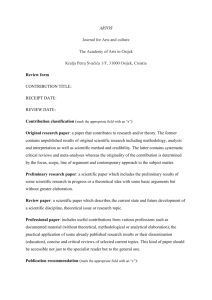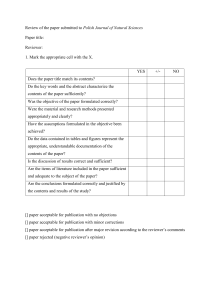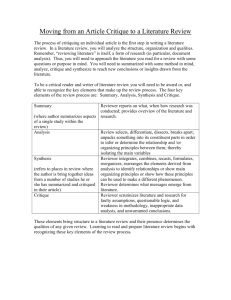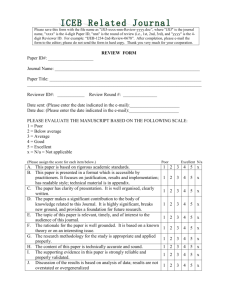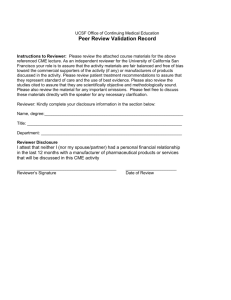Annual Progress Report 2013-2014
advertisement
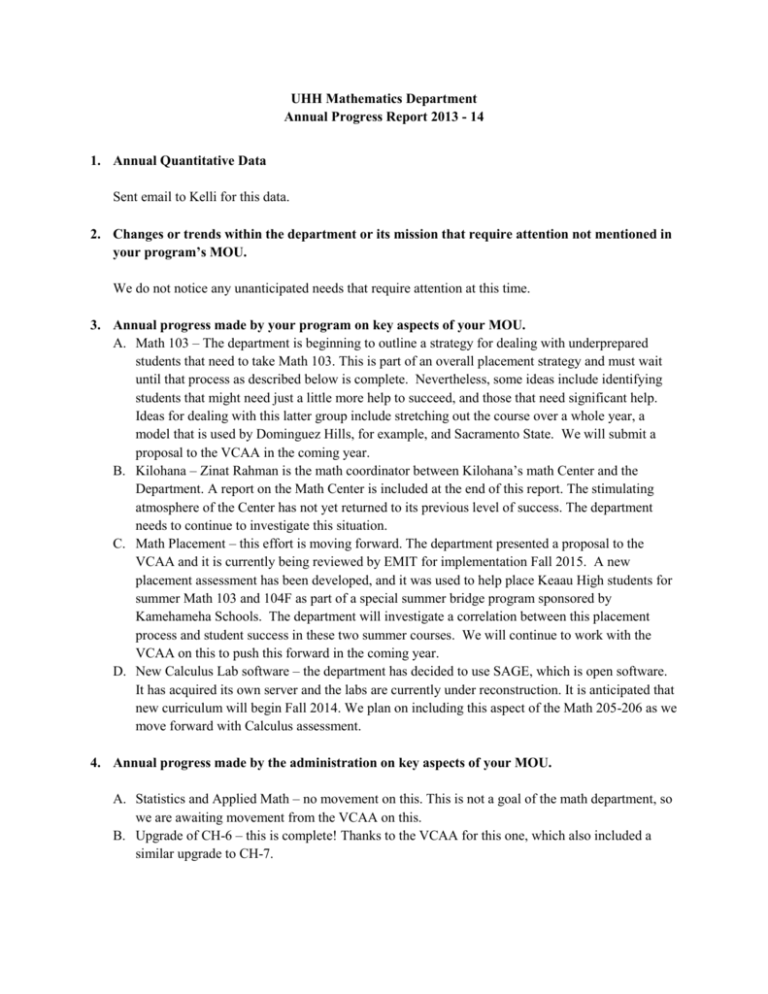
UHH Mathematics Department Annual Progress Report 2013 - 14 1. Annual Quantitative Data Sent email to Kelli for this data. 2. Changes or trends within the department or its mission that require attention not mentioned in your program’s MOU. We do not notice any unanticipated needs that require attention at this time. 3. Annual progress made by your program on key aspects of your MOU. A. Math 103 – The department is beginning to outline a strategy for dealing with underprepared students that need to take Math 103. This is part of an overall placement strategy and must wait until that process as described below is complete. Nevertheless, some ideas include identifying students that might need just a little more help to succeed, and those that need significant help. Ideas for dealing with this latter group include stretching out the course over a whole year, a model that is used by Dominguez Hills, for example, and Sacramento State. We will submit a proposal to the VCAA in the coming year. B. Kilohana – Zinat Rahman is the math coordinator between Kilohana’s math Center and the Department. A report on the Math Center is included at the end of this report. The stimulating atmosphere of the Center has not yet returned to its previous level of success. The department needs to continue to investigate this situation. C. Math Placement – this effort is moving forward. The department presented a proposal to the VCAA and it is currently being reviewed by EMIT for implementation Fall 2015. A new placement assessment has been developed, and it was used to help place Keaau High students for summer Math 103 and 104F as part of a special summer bridge program sponsored by Kamehameha Schools. The department will investigate a correlation between this placement process and student success in these two summer courses. We will continue to work with the VCAA on this to push this forward in the coming year. D. New Calculus Lab software – the department has decided to use SAGE, which is open software. It has acquired its own server and the labs are currently under reconstruction. It is anticipated that new curriculum will begin Fall 2014. We plan on including this aspect of the Math 205-206 as we move forward with Calculus assessment. 4. Annual progress made by the administration on key aspects of your MOU. A. Statistics and Applied Math – no movement on this. This is not a goal of the math department, so we are awaiting movement from the VCAA on this. B. Upgrade of CH-6 – this is complete! Thanks to the VCAA for this one, which also included a similar upgrade to CH-7. 5. Assessment efforts this year. In addition to individual faculty members’ continuing assessment efforts the department participated in the university wide assessment on written communication. The report on this assessment, which was conducted in the Topology course, is included at the end of this report along with the actual assessment instrument and the rubric. The assessment did not identify any deficiencies that need addressing. In fact, it demonstrated strong performance at that level. 6. Assessments efforts planned for next year. We have two assessment efforts planned for the coming year: A. QR and Written Communication Assessment as part of institutional efforts. This will be conducted in Math 431-32. The instrument will be 1 – 2 assigned proofs. The artifact will be the proofs, and we will design rubrics specific to the proofs and then translate them to the QR and Written Communication ILOs. B. Calculus Sequence Assessment: the goal here is to assess certain aspects (TBD) of what we, as a department, feel the Calculus Sequence should achieve. Instead of assessing the numerous skills and concepts presented therein, it would be more informative to assess how successful we are in teaching problem solving/critical thinking skills, which is what our constituents actually want from their students. 7. Student Success this past year (since our program review was submitted) One of the best indications of a department’s success is the success of its students. The Math department has a lot to be proud of in that regard. Our students are accepted in excellent Summer REU programs at UHH, on the US mainland and abroad, give presentations to national conferences, receive recognitions and awards, and are well accepted in the best Mathematics Graduate programs in the US. Just to mention a few of our most recent student accomplishments: In Summer 2013 several of our students were accepted in, and successfully completed, Summer REU programs at UH Hilo PURE Math, REU at Rutgers University, MIT Summer REU Program (MSRP), and Summer Semester in Harvard. For the first time a UHH student was accepted in one of the most prestigious International Mathematics programs in Budapest. A group of our students attended the National SACNAS conference, two students gave presentations, one of them received the Best Student Poster Award. Another student attended the Séminaire de Mathématiques Supérieures conference in Montreal, Canada. Our 2013 graduate Marissa Loving was accepted in the Math Graduate Program at the University of Illinois, Champaign, with full scholarship, TA-ship, fellowship and summer research support. She was also the first UHH student to receive the prestigious NSF Graduate Research Fellowship for Mathematics. The total of Marissa’s various scholarships and fellowships in 2013 was well over $.5 million. 2014: Several students participated in, and some of them presented, at the National Joint Mathematics Meetings in San Diego in January 2014. Several students were accepted in summer REU’s at UHH- PURE Math, REU at San Diego State University, and Mathematics REU program at Texas A&M University at College Station. Our 2014 graduate, Tynan Lazarus, was accepted in the Math Graduate Program at UC Davis with full scholarship and TA-ship. Reuben Tate, junior level math major, received an internship with the USDA (US Dept. of Agriculture). Alyssa Loving, also a junior, was accepted into both of the two most prestigious Math programs in the world: Semester of Mathematics in Moscow and Mathematics in Budapest. Math Center at UH Hilo 2013-14 The Math Center, housed in College Hall 5 and administered by Kilohana, offers free walk-in tutoring for most 100- and 200-level Mathematics courses at UH Hilo. The tutors, who are mostly Mathematics majors, are recommended by Mathematics faculty and selected by the Math Center coordinator. Two of these coordinators have been recent UH Hilo Mathematics graduates. Beginning in Spring 2012, however, this position is held by Zinat Rahman, who is also a member of the Mathematics department. Having a coordinator with a dual appointment in the Math Center and the Mathematics Department has fostered increased communication and cooperation between Mathematics faculty and Math Center tutors. Beginning in Spring 2012, various initiatives were established to improve tutor preparation and interaction with faculty. Most notable is the Math Center Laulima site, which provides a forum in which professors can post homework, quiz, and test information. Many tutors have commented that this site allows them to become better informed about specific course assignments and gives them opportunities to review relevant topics before interacting with students. Another initiative is the faculty-tutor mixer at the beginning of the term, which encourages dialogue and answers some initial logistical and pedagogical questions related to Math Center tutoring. As a result of these initiatives, Mathematics faculty members more regularly publicize the Math Center and encourage their students to make use of this resource. These faculty members note that since the tutors have direct access to course assignments and deadlines, they are increasingly confident that the tutors can more effectively provide academic support. For this semester Spring, 2014 the Math Center is offering 47 hours tutoring every week including 4 hours tutoring on Saturday and we have 7 tutors currently working with the Math Center. 232 students visited the Math Center in Fall, 2013 (8/28/2013 to 12/18/2013) whereas in Spring 2014 (1/1/2014 to 4/27/2014) 182 students visited. In Fall, 2013 the total number of visiting hours was 1902.6 and in Spring, 2014 total visiting hours was 1387.5. Among all the math courses for which we offer tutoring, in Fall, 2013, 73 students visited for Math 205 (584.94 hours for tutoring) and for Math 206, 42 students visited (388.81 hours for tutoring). Whereas, in Spring, 2014, 57 students visited for Math 205 (303.73 hours of tutoring) and math 206, 39 students visited (522.95 hours of tutoring). Most of the students come to seek help for Math 205 and 206. Mathematics Spring 2014 Topology Written Communication Assessment Report: Academic Year: 2013-2014 Report Date: Thursday May 8th, 2014 Assessment Project Coordinator: Dr. Brian Wissman Faculty Involved: Dr. Mitchell Anderson, Dr. Zorana Lazarevic, Dr. Brian Wissman 1. Student Learning Outcomes Assessed for the present academic year: Two aspects of the Written Communication Institutional Learning Outcomes were assessed for both the Traditional Track and Teaching Track Mathematics majors: Line of Reasoning, which also includes Critical Thinking, and Organization and Structure. These also correspond to Mathematics Program Learning Outcomes 4 (Reasoning): Use a variety of theorem-proving techniques to prove mathematical results; and Outcome 5 (Communication): Demonstrate the abilities to … articulate mathematics … in writing. The full list of Program goals are listed on the University of Hawaii at Hilo web page, http://hilo.hawaii.edu/catalog/mathematics.html. 2. Curriculum Map: Work from students in Math 314: Topology is used for this assessment. This class at UH Hilo is designed to supplement students' transition from largely computational mathematics, such as the calculus sequence, to a more rigorous theorem and proof based class. While the prerequisites assume no prior mathematical proof experience, about three quarters of the class had taken our Math 310: Discrete Mathematics class which serves as the official (required) transition class between computational and proof based mathematics. Most of these students will take the Math 431: Mathematical Analysis class the following fall semester, which is where they Master theorem proving. Our Topology class focuses on developing mathematical writing skills and clearly presenting mathematical proofs, and is thus particularly well suited for assessment of both Line of Reasoning and Organization. 3. Audience: The class is mainly populated by Mathematics majors, with a few other Natural Science majors working on their minor in Mathematics. Moreover, the majority of students are in their Junior year, with a few advanced Sophomores. 4. Assessment Details: Students in the class were each given an identical mathematical statement to prove, type up carefully using the open source LaTeX publishing system, and submit. This was part of a bi-weekly homework assignment. A rubric was developed (See Appendix) where three criteria regarding Line of Reasoning and Organization were scored. Each of the six categories were assigned a value of 1-4, then combined to get an overall score between 1-4. The rubrics were developed by the participating faculty by analyzing the proof using proper mathematical writing and logic. Each of the faculty involved individually scored each of the fourteen submissions and then the results were discussed as a group. The actual assessment instrument, rubric, and raw results and averages of the data were collected and are presented below. 5. Results and Analysis: On the whole, most students were able to demonstrate competency in both their Line of Reasoning and Organization. The overall averages were an identical 3.19 out of a total possible of 4 for areas. Only a few showed major deficiencies in the overall line of reasoning (for example, choosing the correct supporting theorem, but utilizing it logically backwards), or the ability to communicate their proof well. (For example, some did not clearly define variables or objects in their proof.) The faculty scoring the work noticed that in the future rubrics should be flexible to account for correct proofs that are presented using a different approach. This arose in particular for the first assessed category under Line of Reasoning, “Used the definition of open and closed sets for the empty set and X.” After review, there was a discussion on how explicit students should be. Many did not explicitly state that both the empty set and X were open because they are in the topology by the definition of a topological space. Instead, they just stated it. (Which we all agreed would be a perfectly acceptable practice on a homework, exam, or even published mathematical work as this is common knowledge to students in class.) Nevertheless, some students were marked lower because of this. Several students, while giving a technically correct proof, adopted some questionable variable names. One example in particular, two students used “O” to designate a closed set, where “O” is almost universally used for an open set. To an outside reader, this may reduce the readability of the work. One more quality assessed under Line of Reasoning was “Proceeds one step at a time.” Some students combined two steps correctly in one statement so it was the reviewers’ opinion that a better mark for the future would be “Overall Line of Reasoning.” In conclusion, the rubric played a more important role than anticipated and hence needs to be carefully developed. 6. Closing the Loop Results of this assessment were presented to the Mathematics department. The assessment did not reveal any glaring deficiency that needs to be addressed. On the contrary, it appears that our major program goals associated with written communication are being met by adequately preparing our majors to succeed in their senior level Mathematical Analysis and Modern Algebra classes (Math 431/432, Math 454/455 respectively) by providing a strong foundation in their mathematical logic and proof writing, two qualities essential for success as a Mathematics major. These results will also be utilized to develop the most effective rubrics for future assessment efforts. The department plans to repeat this type of assessment in conjunction with its QR assessment scheduled for next year, at the senior level in Math 431-432. MATH 314 TOPOLOGY WRITTEN COMMUNICATION ASSESSMENT SPRING 2014 Result to Prove: Let (X, T) be a topological space. Show that X and are closed sets. Show that the finite union of closed sets is closed, and the arbitrary intersection of closed sets is closed. For each part assign a score of 1,2,3, or 4, giving a total possible score from 3 to 12 in both Organization and Line of Reasoning. For overall scores, total scores of 3-4 are to be assigned an overall score of 1; 5-7, overall 2; 8-10, overall 3; and 11-12, overall 4. For example if an assignment received 9 total points on Organization and 7 on Line of Reasoning, they would receive QR institutional rubric scores of 3 and 2 respectively. Organization: The author, is clear about what is needed to be proved at each step. (1-4) proceeds one step at a time. (1-4) defines their closed sets prior to using it. (1-4) Line of Reasoning: The author, used the definition of open and closed sets for and X. (1-4) used the definition of open and closed for each of their sets in the union. (1-4) used DeMorgan’s Laws. C ( A B) C (A) C(B) and C ( A B) C (A) C(B) (1-4) Student 1 Reviewer 1 Reviewer 2 Reviewer 3 2 Reviewer 1 Reviewer 2 Reviewer 3 3 Reviewer 1 Reviewer 2 Reviewer 3 4 Reviewer 1 Reviewer 2 Reviewer 3 5 Reviewer 1 Reviewer 2 Reviewer 3 O rg a n iz a t io n Is clear about Proceeds on step at what is needed to be a time. (14) proved at each step. (14) T o ta l S c o re Ove ra ll Score 3-4: Score 1 5-7 Score 2, 8-10 Score 3, 11-12 Score 4 Defines their closed sets prior to using it. (14) L in e o f R e a s o n in g Used the definition of open and closed sets for empty set and X. (1-4) T o ta l S c o re Ove ra ll Score Applied Used the defintion of DeMorgan's Laws. (1-4) open and closed for each set. (14) 4 4 4 4 4 4 3 2 3 11 10 11 Average: 4 3 4 3.67 3 4 4 4 4 4 4 4 4 11 12 12 Average: 4 4 4 4.00 2 1 2 4 4 4 3 2 2 9 7 8 4 4 4 3 4 4 4 4 4 Average: 3 2 3 2.67 11 12 12 Average: 4 4 4 4.00 10 9 8 Average: 3 3 3 3.00 2 1 2 2 1 3 3 4 2 7 6 7 2 2 2 2.00 10 10 11 Average: 3 3 4 3.33 4 4 4 7 7 9 2 2 3 2.33 12 11 12 Average: 4 4 4 4.00 3 1 3 9 6 9 3 2 3 2.67 2 4 2 4 4 3 4 4 4 4 2 2 4 3 4 4 3 4 4 3 4 2 3 4 4 4 4 Average: 2 1 3 1 2 2 Average: 3 2 3 3 3 3 Average: 6 Reviewer 1 Reviewer 2 Reviewer 3 3 2 4 3 3 4 4 4 4 10 9 12 Average: 3 3 4 3.33 4 1 3 3 2 4 4 4 4 11 7 11 Average: 4 2 4 3.33 7 Reviewer 1 Reviewer 2 Reviewer 3 4 4 3 3 2 2 3 1 2 10 7 7 Average: 3 2 2 2.33 2 3 4 4 1 3 4 4 4 10 8 11 Average: 3 3 4 3.33 8 Reviewer 1 Reviewer 2 Reviewer 3 2 1 2 1 1 2 1 1 1 4 3 5 3 1 2 1 1 3 1 1 2 5 3 7 Average: 1 1 2 1.33 Average: 2 1 2 1.67 9 Reviewer 1 Reviewer 2 Reviewer 3 4 3 4 3 3 4 4 4 4 11 10 12 Average: 4 3 4 3.67 4 1 3 4 3 3 3 4 4 11 8 10 Average: 4 3 3 3.33 10 Reviewer 1 Reviewer 2 Reviewer 3 4 3 4 3 4 4 4 4 4 11 11 12 Average: 4 4 4 4.00 4 4 4 4 3 4 3 2 4 11 9 12 Average: 4 3 4 3.67 11 Reviewer 1 Reviewer 2 Reviewer 3 3 3 3 3 4 4 3 3 3 9 10 10 Average: 3 3 3 3.00 4 4 4 4 3 4 3 3 4 11 10 12 Average: 4 3 4 3.67 12 Reviewer 1 Reviewer 2 Reviewer 3 4 2 4 4 4 4 4 2 3 12 8 11 Average: 4 3 4 3.67 3 1 3 3 2 4 4 4 4 10 7 11 Average: 3 2 4 3.00 13 Reviewer 1 Reviewer 2 Reviewer 3 4 4 4 4 4 4 4 4 4 12 12 12 Average: 4 4 4 4.00 4 4 4 4 4 4 4 4 4 12 12 12 Average: 4 4 4 4.00 14 Reviewer 1 Reviewer 2 Reviewer 3 3 1 3 4 1 4 3 2 4 10 4 11 Average: 3 1 4 2.67 4 4 4 4 2 4 4 4 4 12 10 12 Average: 4 3 4 3.67 O rg a n iz a t io n A v e ra g e : 3.19 L in e o f R e a s o n in g A v e ra g e : 3.19



